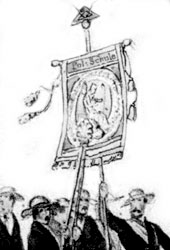|

The expansion of mathematics training was an important step in the general direction of polytechnical teaching institutions as a whole. But even with a new name, the search continued for the best possible form of the Polytechnical School in Stuttgart. (In Karlsruhe it was said that the Stuttgart school didn't know whether it wanted to serve vocational or academic needs, and that its true character was still "fermenting".)
The 1840s saw a whole host of smaller steps. The task of conducting the one-year preparation course was handed over to secondary schools, allowing the four years to be used exclusively for specialist training. In line with this, the entrance age was raised to 15. Classes for the winter pupils were transferred to a special Winter Building School, which in turn marks the beginning of higher specialist technical schools in Württemberg. As a result of these developments, the Polytechnical School was able to pass less central aspects of training onto other establishments and to thus develop a clear specialist profile.
In 1847/48 the Polytechnical School also consolidated its core competences in its specialist fields by employing its own highly qualified senior teachers of Chemistry, Mechanical Engineering and Civil Engineering. Hermann Fehling, a pupil of Liebig, introduced modern laboratory-based chemistry training. The teachers of Civil Engineering and Mechanical Engineering had been trained in Paris and Karlsruhe, the very institutions that were role models for all polytechnical schools at the time.
The next major reform was brought about by the new statutes of 1862. Schooling was now extended to five years, with the additional year devoted to mathematical training. The school entrance age was raised, to 16 for the junior mathematical section and 18 for the senior technical section and its specialist schools. Entrance exams were introduced to guarantee pupil standards. At the same time changes were made to the supervisory authority. The Polytechnical School was now no longer under the control of the Study Council, which was in charge of the entire school system, but was governed by the Ministry for Church and School Affairs – as was the University of Tübingen. Shortly afterwards the senior teachers were given a status equal to that of university professors.
Even though these changes may seem minor and even bureaucratic to us today, they do show that Stuttgart's character was no longer "fermenting". The Polytechnical School was on the road to becoming an academic institution on a par with universities.
| 1839 - 1883 |
Hermann Fehling
Senior teacher of Chemistry and Technology – Professor from 1867 onwards |
| 1840 |
Vocational School is renamed Polytechnical School |
| 1847 |
Foundation of the first student fraternities
Foundation of the Stauffia fraternity; numerous others are founded in the following years |
| 1862 |
Structural reforms
Divided into two sections: a junior mathematical section for pupils aged 16-18 and a senior one with four specialist schools (Architecture, (Civil) Engineering, Mechanical Engineering, and Chemical Engineering) |
| 1869 - 1877 |
Friedrich Theodor Vischer
Professor of German Literature and Aesthetics |
| 1870 |
Expansion of the Polytechnical School
A Mathematics and Sciences School and a General School are added to the specialist schools |
| 1876 |
Name changed to Polytechnic
Moves closer to university status by abolishing the two mathematics pre-school classes and introducing a new entrance qualification (secondary school leaving examination is required) |
|
 |
